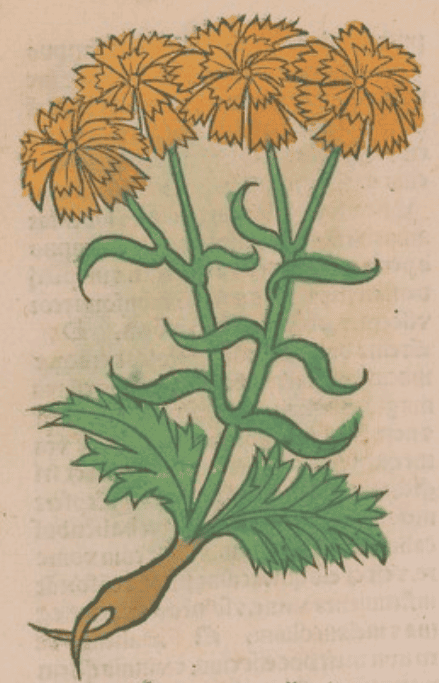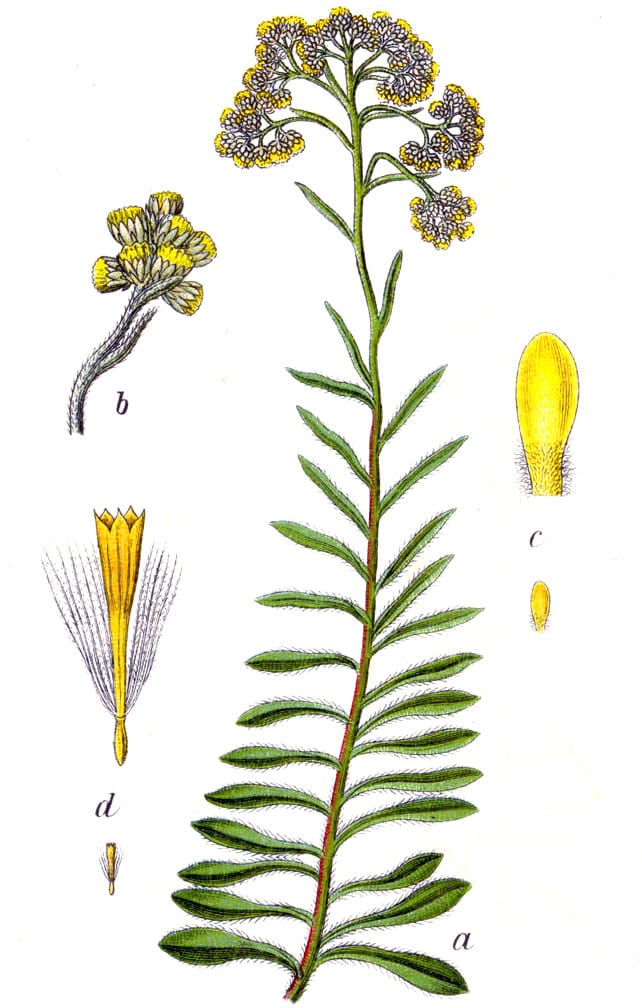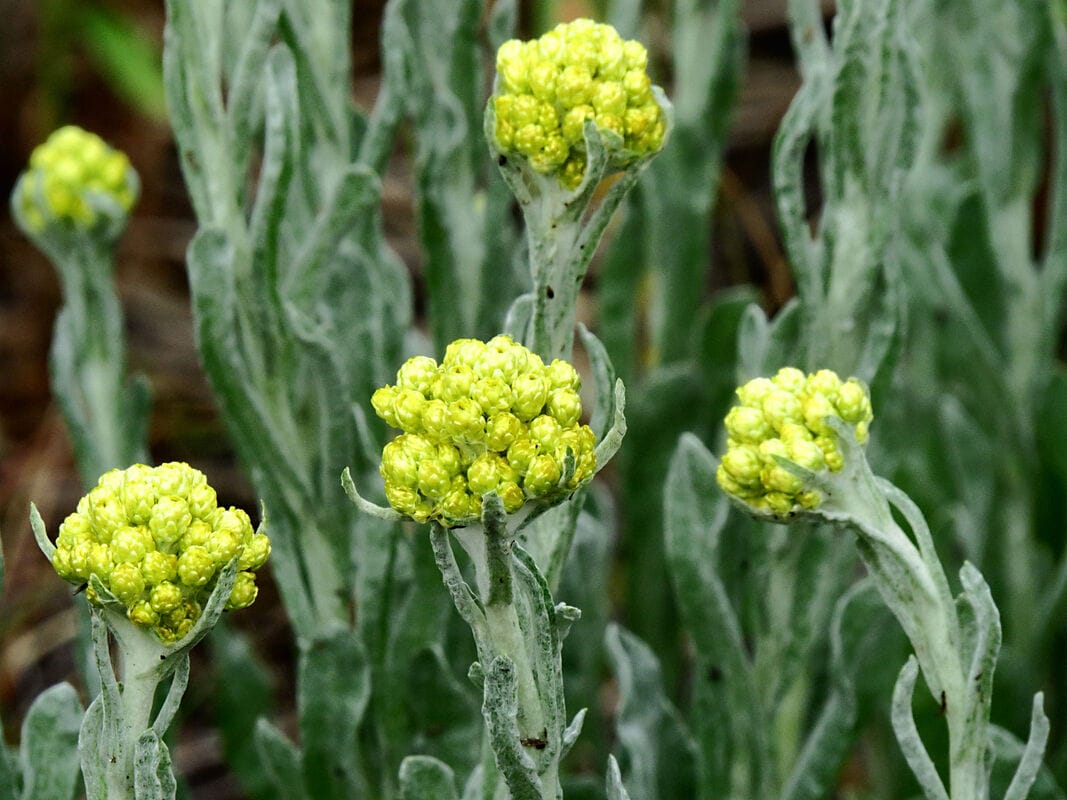Helichrysum, Yellow Everlasting
Immortelle, Eternal Flower, Sandy Everlasting, Strawflower Ortus Sanitatis, Meydenbach, 1491
Ortus Sanitatis, Meydenbach, 1491 Helichrysum arenarium
Helichrysum arenariumDeutschlands Flora in Abbildungen, Sturm, 1796
 Helichrysum arenarium
Helichrysum arenarium(Photo by Аимаина хикари) (Wikimedia)
Botanical name:
Helichrysum arenarium (syn. Gnaphalium arenarium)
There are over 300 species and many sub-species. Those of the Mediterranean are broadly grouped into large-flowered (ie. H. stoechas) and small-flowered (ie. H. italicum) varieties. However, their effects and uses are largely synonymous. Other species used include:
1. H. italicum
2. H. angustifolium
3. H. bracteatnm
Parts used:
Flower, or Whole Herb in flower
Temperature & Taste:
Cool, dry. Bitter, Pungent
Constituents:
-Chalcones
-Flavonoids: naringenins
-Flavonols: kaempferol, quercetin
-Flavones: apigenin, luteolin, scutellarein
-Phenols: caffeic acid, ferulic acid, chlorogenic acid, sinapic acid, vanillic acid, gentisic acid
-Coumarins: scopletin, umbelliferone
-Sterols: beta-sitosterol, stigmasterol
-Glycosides
-Essential oil (0.04–0.09%)
Uses:
1. Clears Liver Heat and Damp:
-Jaundice, Hepatitis
-Cholecystitis, Gall Stones; improve Gall Bladder function (TCM, Russia)
-Hepatoprotective
-Psoriasis
2. Benefits Kidneys, Clears Damp-Heat:
-Edema; Difficult or Painful Urination
-Gout, Rheumatism
-Back and Hip pain, Sciatica (medical Wine)
-chronic Nephritis with difficulty urinating
-Paralysis
-used to activate Adrenal Glands (Russia)
3. Moves the Blood:
-promotes menstruation
-“dissolves blood clots in the bladder or abdomen”, taken with Wine (Dioscorides)
-useful for Atherosclerosis
-Venous Stasis, Chilblains, Hemorrhoids
4. Clears Heat, Benefits Digestion:
-Indigestion, Poor Appetite
-Gastritis (Russia)
-Hernia
5. Clears Wind-Heat, Stops Cough, Resists Poison:
-Laryngitis, Cough, Bronchitis
-Dyspnoea
-Catarrh
-Snake Bite (Dioscorides)
6. Kills Worms:
-regarded as useful for Worms, especially in Children (Russia)
7. Externally:
-Wounds and Burns, apply with Honey (Theophrastus)
-Sunburn and Burns (flower in olive oil)
Dose:
Infusion: a heaped teaspoonful (3–4 grams), several times daily
Brief Decoction: 6–12 grams, or Decoction (1 in 20): 100 mls, 2–3 times daily.
Comment:
A Russian proprietary medicine called Flamin is derived from the flavonoids of Helichrysum and is prescribed for chronic cholecystitis.
Main Combinations:
1. Chronic Gastritis, Yellow Everlasting with Nettle, Yarrow, Camomile, Chicory, Calendula, Hops
2. Cholecystitis, Yellow Everlasting with Chicory, Dandelion and Bitter Orange peel
3. Topically for pain, Yellow Everlasting, Camomile, Marjoram
Major Formulas:
Cautions:
1. Some sources (ie. Duke) have warned against using it in cases of Gall Stones. However, Gall Stones is a TCM indication. It should be combined with spasmolytic herbs when used to treat Gall Stones.
Main Preparations used:
- Extra Info
-
Research
2. Phytochemical Analysis, Antioxidant and Antimicrobial Activities of Helichrysum arenarium (L.) Moench. and Antennaria dioica (L.) Gaertn. Flowers.
3. Anti-atherosclerotic activities of flavonoids from the flowers of Helichrysum arenarium L. MOENCH through the pathway of anti-inflammation.
4. Helichrysum arenarium subsp. arenarium: phenolic composition and antibacterial activity against lower respiratory tract pathogens.
5. [Antituberculous in vitro activity of Helichrýsum arenárium extract].
6. Medicinal flowers. XXVII. New flavanone and chalcone glycosides, arenariumosides I, II, III, and IV, and tumor necrosis factor-alpha inhibitors from everlasting, flowers of Helichrysum arenarium.
7. [An orientational examination of the effects of extracts from mixtures of herbal drugs on selected renal functions].
